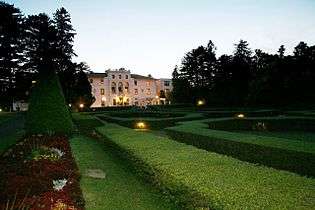Harrie T. Lindeberg
| Harrie T. Lindeberg | |
|---|---|
| Born |
1879 Bergen Point, New Jersey |
| Died |
1959 Long Island, New York |
| Nationality | United States |
| Occupation | Architect |
| Practice | New York City |
| Buildings | country houses |
| Projects | Amelita Galli-Curci Estate |

Harrie Thomas Lindeberg (1879–1959) was an American architect, best known for designing country houses in the United States. Among academic eclectic architects Lindeberg found a niche as "the American Lutyens" by working in a variety of popular styles while imparting a crisp modern stamp to his work. He might best be compared to contemporary Art Deco and Streamline Moderne skyscraper architects such as Raymond Hood, Ely Jacques Kahn, and Ralph Thomas Walker.[1]
Biography
Harrie Thomas Lindeberg was born in Bergen Point, New Jersey in 1879. He studied architecture at the National Academy of Design from 1898 to 1901. Lindeberg then began his career as an assistant draftsman with the noted architecture firm of McKim, Mead & White, where he worked until 1906. He served as an assistant to Stanford White on the James L. Breese House in Southampton, New York. He and fellow McKim, Mead & White draftsman Lewis Colt Albro began their independent partnership in 1906 and worked together until 1914.[2]
After the partnership dissolved, Lindeberg continued to design works that ranged from large country estates to suburban villas. His office received commissions from across the United States. His clients included many of the leading business, professional and cultural figures of the era. In Chicago he designed fine residences on the North Shore for the Armour family; in Houston his clients included many oil barons who resided in the "Shadyside" district; in New Jersey he built for Wall Street figures and businessmen such as Gerard Lambert; on Long Island his clients were self-made millionaires in the mold of Jay Gatsby. His best-known houses include Glencraig for Michael Van Beuren in Middletown, Rhode Island and the Paul Moore residence (now demolished) in Convent Station, New Jersey.[3]
Notable buildings
- Nester House, 1911, Geneva, New York. Listed on the National Register of Historic Places in 1984.[4]
- Southways (John S. Pillsbury estate), 1919, Orono, Minnesota.
- Amelita Galli-Curci Estate, 1922, Fleischmanns, New York. Listed on the National Register of Historic Places in 2010.[5]
- Carter Hall, 1930 remodel, Millwood, Virginia. Listed on the National Register of Historic Places in 1973.[4]
- Morrocroft, 1925-1927, Charlotte, North Carolina. Listed on the National Register of Historic Places in 1983.[4]
- Philip D. Armour III House, 1932, Lake Bluff, Illinois. Listed on the National Register of Historic Places in 1996.[4]
- Embassy of the United States, Helsinki, Finland, 1938. Modelled after Westover Mansion in Virginia.[6]
References
- ↑ See Mark Alan Hewitt, "Introduction, Domestic Architecture of H.T. Lindeberg, Acanthus Press, New York, 1996
- ↑ Kathleen LaFrank (May 2010). "National Register of Historic Places Registration: Amelita Galli-Curci Estate". New York State Office of Parks, Recreation and Historic Preservation. Retrieved 2010-02-14.
- ↑ Mark Alan Hewitt, The Architect and the American Country House: 1890-1940, Yale Univ. Press, 1990; Mark Alan Hewitt, "Lindeberg, Harrie Thomas, in the Oxford American National Biography online http://www.anb.org/articles/17/17-01312.html?a=1&f=%22harrie%20t%20lindeberg%22&d=10&ss=1&q=1
- 1 2 3 4 National Park Service (2009-03-13). "National Register Information System". National Register of Historic Places. National Park Service.
- ↑ "National Register of Historic Places Listings". Weekly List of Actions Taken on Properties: 8/16/10 through 8/20/10. National Park Service. 2010-08-27.
- ↑ Sennott, Stephen. Encyclopedia of Twentieth Century Architecture, p. 401, at Google Books.
External links
- The Architectural Library of Harrie T. Lindeberg, Long Island University
- Harrie T. Lindeberg, Architect, collections, 1910-1930s, Lake Forest College Library Archives and Special Collections
- Pictures and Information on Harrie T. Lindeberg's Historic Long Island Commissions